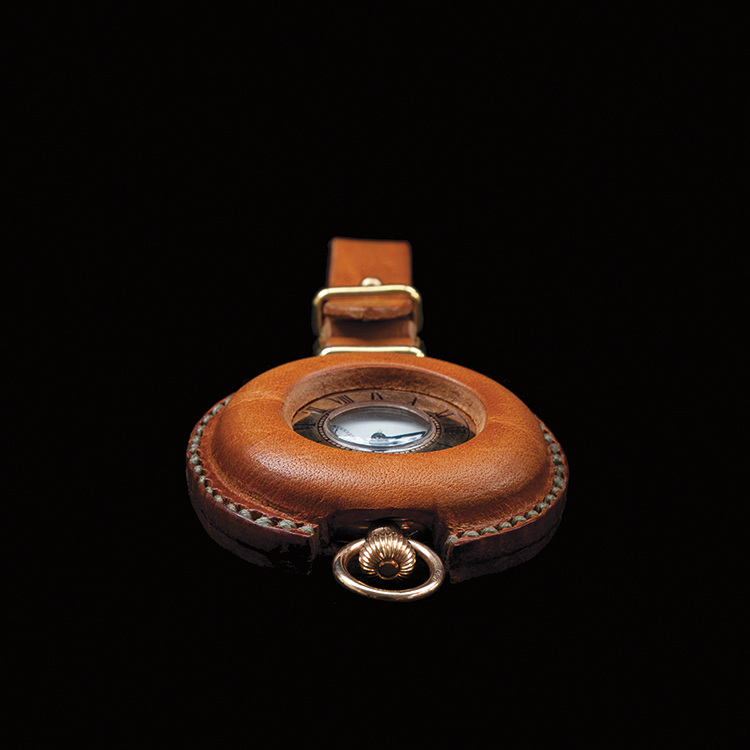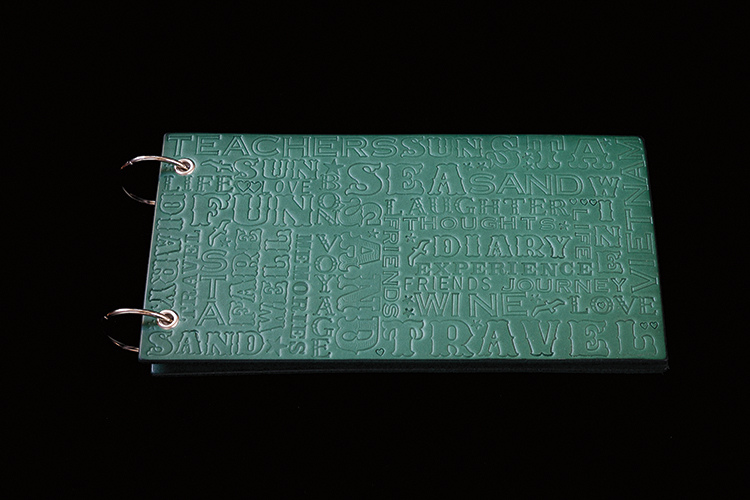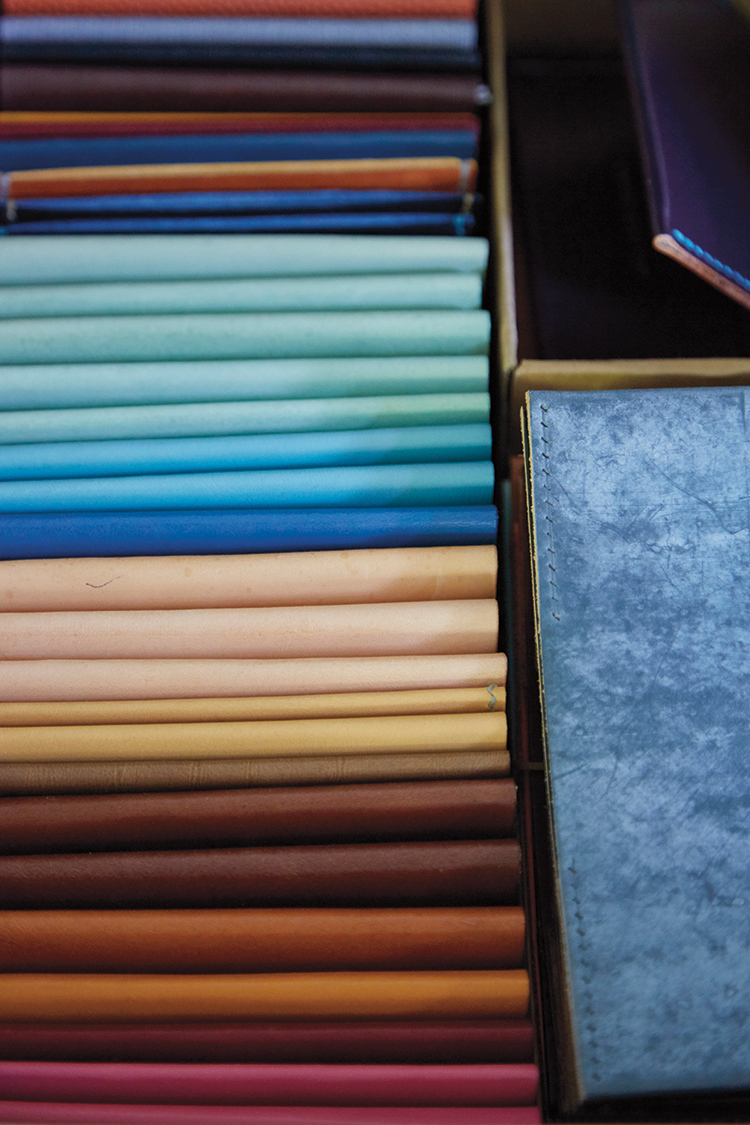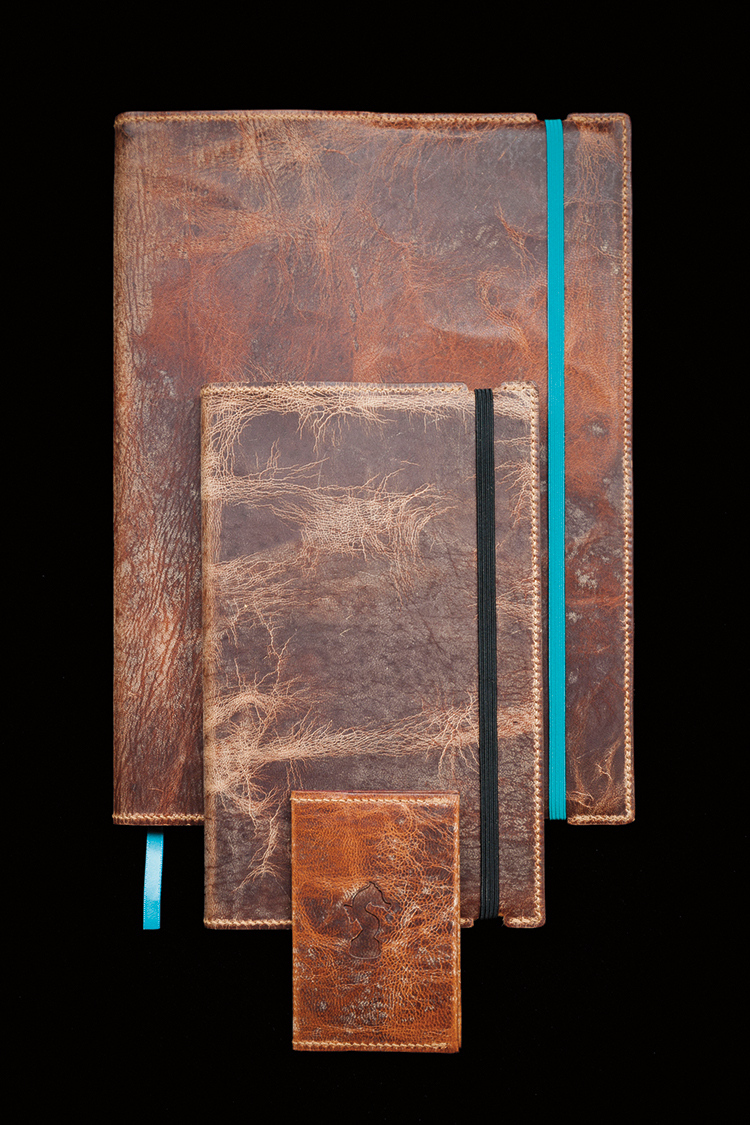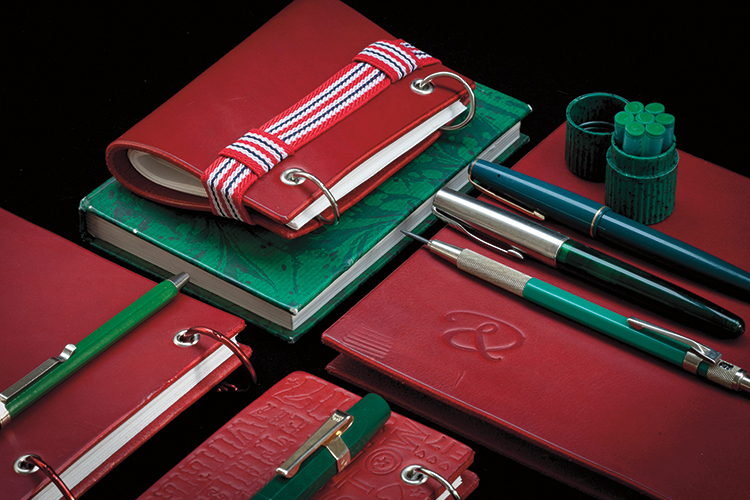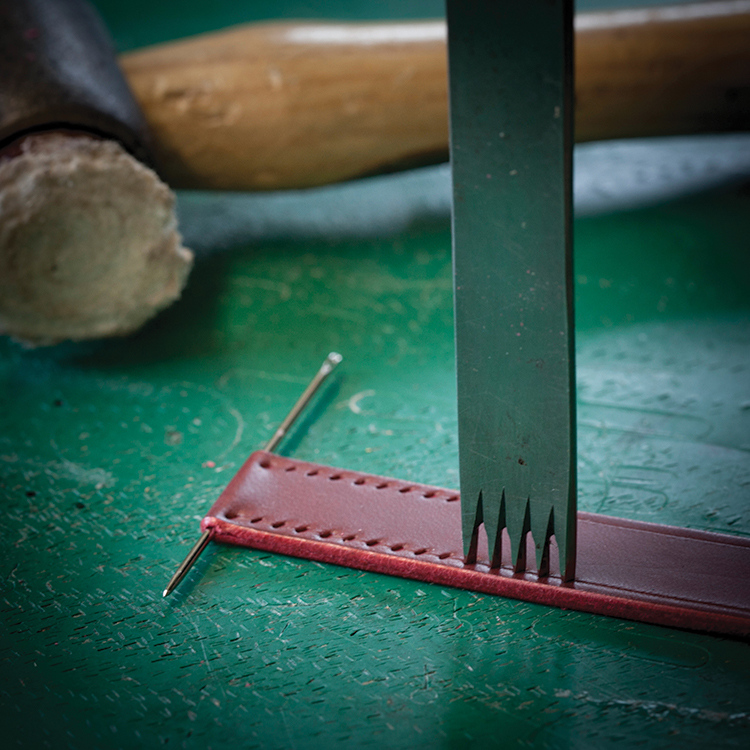Brought up in a creative and industrious family in London, at the age of 8, I watched and learned how to turn banister rails from my Master Carpenter grandfather and helped my mother and grandmother sew children’s and toy clothing to sell at markets. I’ve always enjoyed making things.
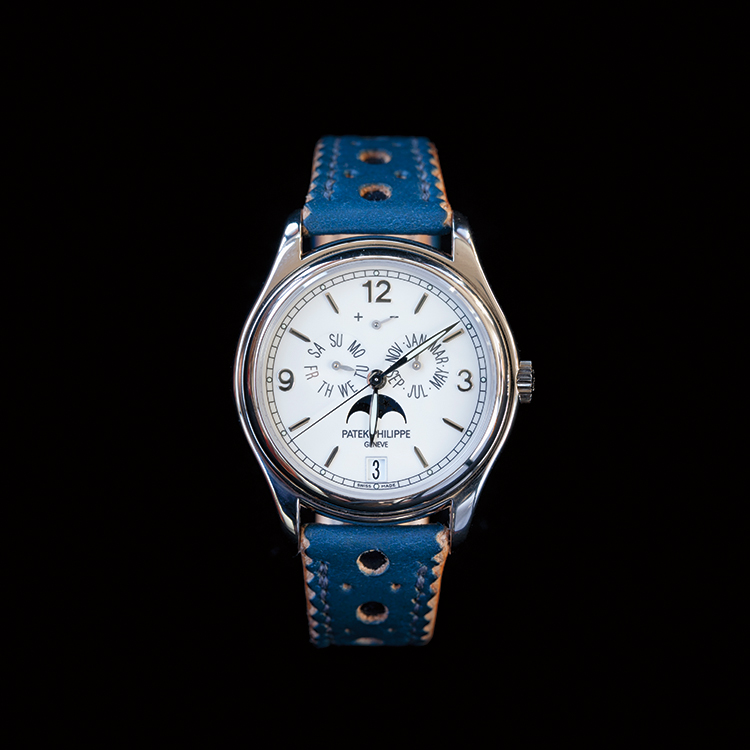
I spent the first five years of my varied careers in the theatre running a youth theatre in London and became a professional stage manager touring theatres, schools, and the Edinburgh Fringe. I then decided I wanted to pursue a creative education and went to art college, gaining a (hard to achieve!) First Class Degree in Graphic Design (BA Hons) at the famous St Martins College of Art & Design in London. A career as a creative producer followed in the early interactive CD-ROM and subsequent website era working for agencies such as Razorfish. This career culminated in my becoming Creative Director and Brand Manager, running a 20-strong, award-winning design team I developed there, and overseeing the brand at the innovative online financial services company Egg.
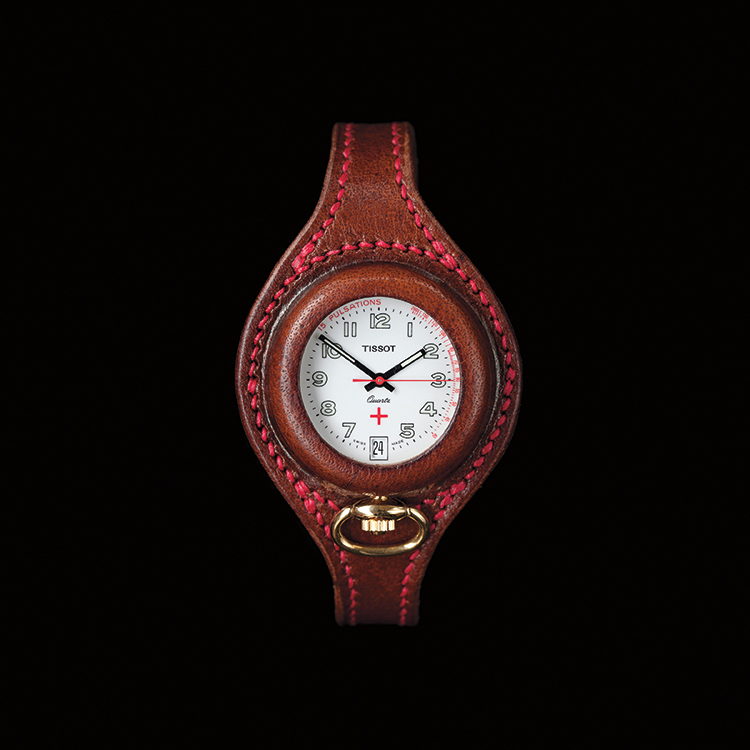
Sitting at my desk on the 17th floor of Canary Wharf in London, managing a team of creatives, I wondered how I had gotten there and where my own creativity was going. I wanted to do something hands-on, something practical and traditional. I had considered tailoring and millinery, but I loved the idea of working with horses, of being a saddler. A brave move after a successful 25-year career in brand, design, and theatre, in 2008 I left my job in the city to retrain as a Saddler and start my leather business. I gave up a well-paid job with benefits for a self-funded, full-time training at the only 2-year saddlery course in the county — a mere 10 miles from home.
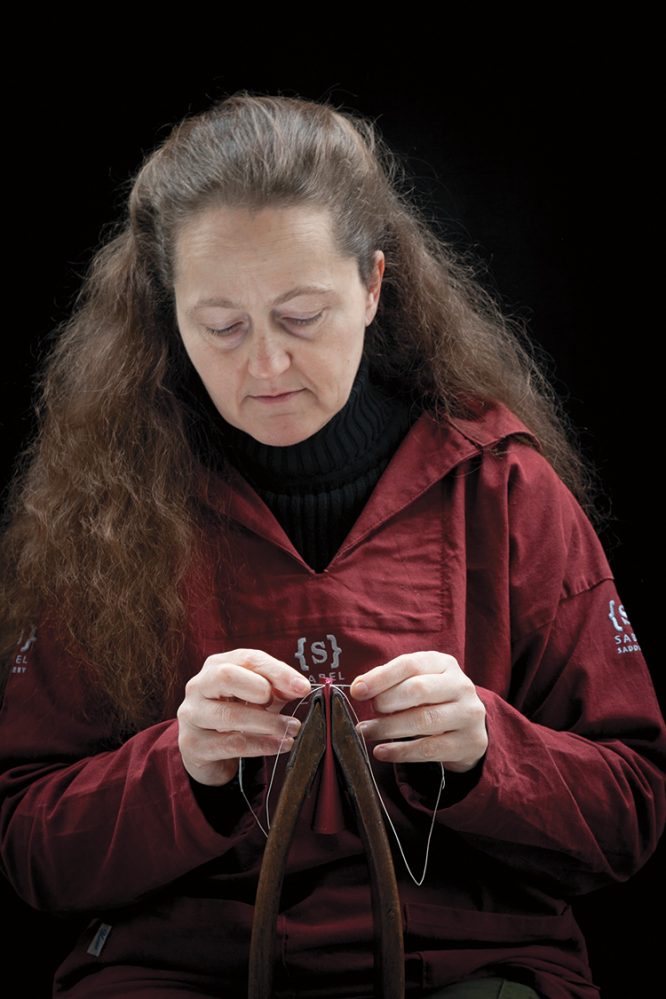
In 2010, a Queen Elizabeth Scholarship Trust (QEST) Scholarship enabled me to expand on this training, become a Qualified Saddler, and augment my skillset in other leather crafts such as upholstery, bag making, and restoration.
Four years later, I completed the Walpole Crafted Mentorship programme, which helped me to focus my offering and concentrate on marketing my watch strap services to a luxury market—at the time, I may have been the only person in the UK to make and fit watch straps with a single hole. I arrange personal consultations to help the customer make decisions about the design of the strap: shape, leather and thread colours, additional features, and take detailed measurements. Once the strap is made, I arrange for a customer fitting, adding a single hole for a unique, customised fit (or 3 holes for mail order). It’s not a surprise I’m known as the “Watch Tailor.”
One of my customers said: “People underestimate the impact of a strap on a watch. A strap can transform a watch into something entirely different than people are accustomed to. It allows you to personalise a watch and tweak its presentation in order to make it align with your personal aesthetic and style.”
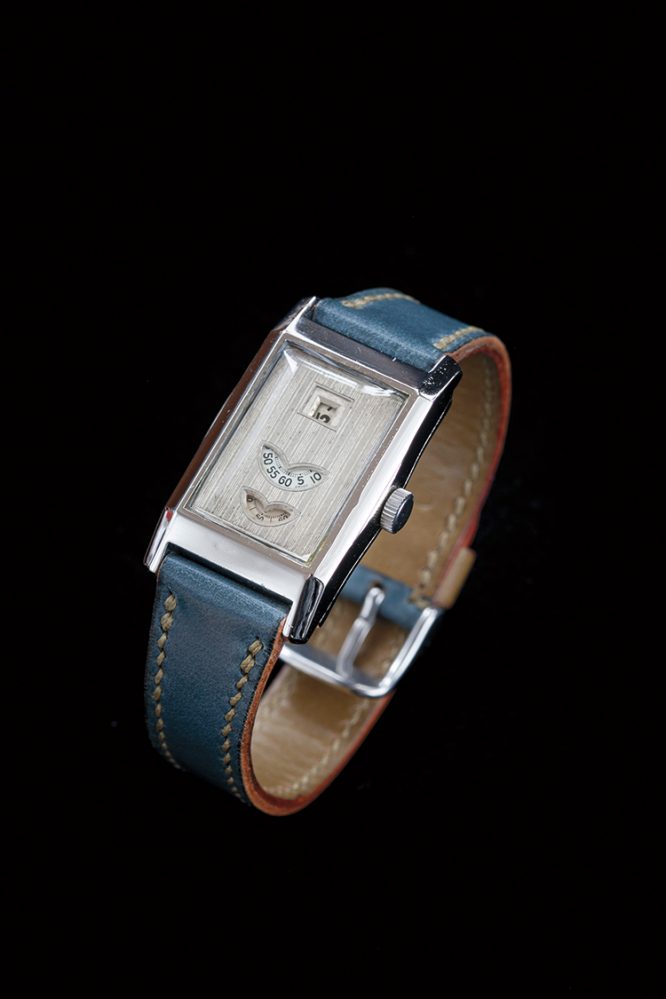
Like a bespoke jacket, the contrasting lining of a (watch) strap can discretely express your individuality.
I love working with leather—I love the smell, the feel, and the way I can manipulate it into complicated forms. Inspired by traditional saddlery techniques, materials, and aesthetics, my products are hand-cut from thick, top-grade, full-grain vegetable-tanned leather, often bridle leather used in saddlery for its strength. My favoured leather is oak bark leather from the only traditional oak bark pit-tannery in Britain, J&FJ Baker & Co. in Devon, where there has been a tannery since the Roman times.
Leather is such a versatile, durable material, and I am content in using a by-product of the meat industry, creating products that will last a lifetime.

I prepare leather by hand cutting, using a double-head knife, a tool that looks like a viking helmet. With practice, you can become efficient at cutting and skiving (thinning) using this tool. I have sourced saddlery tools from many locations, from retired Saddlers, bought new-old stock, and scoured eBay—some tools are very difficult to find, and even the modern ones aren’t always made as well as they used to be.
Leather is prepared for stitching using a stitch-marker, or pricking iron, a tool that looks like a fork. It is available in a variety of widths, depending on the quantity of stitches per inch you require, and is used to mark, not punch through, the leather. That is often a rookie mistake, inevitably damaging the tool.
“A thing of beauty is a joy forever; its loveliness increases; it will never pass into nothingness.”
John Keats (1795-1821) from “Endymion” Book 1
People are surprised that I only stitch by hand—I don’t use a sewing machine. They often comment—does it hurt? You must have strong fingers? Well, no, it doesn’t, and maybe I do, but it’s all in the preparation and technique.
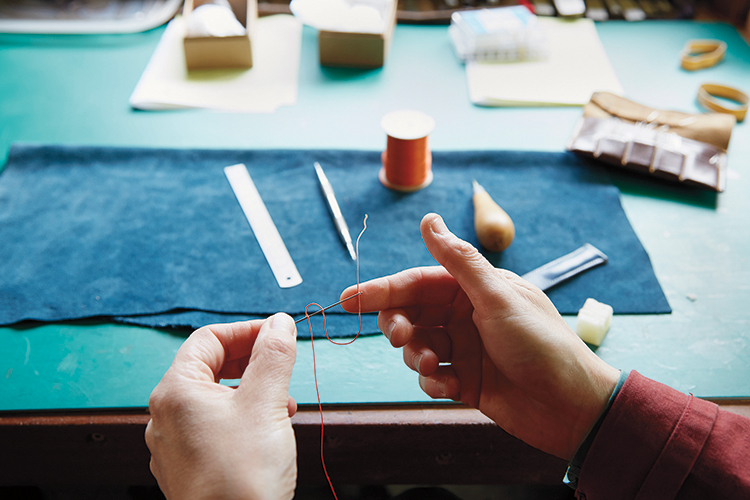
Two needles are used, one threaded at each end of an armful length of linen thread. The thread is hand-waxed to stop it from twisting—strengthening, and protecting it. Linen, once wet, actually gets stronger, which is why it is used on horse tack, having to endure mud, sweat, rain, and tears.
A doublehanded saddler’s stitch is stronger than machine stitching as it creates a figure of eight through the holes, and it doesn’t unravel if a stitch is broken. What happens when you pull a loose thread on a machine-stitched bag? It unravels, of course.
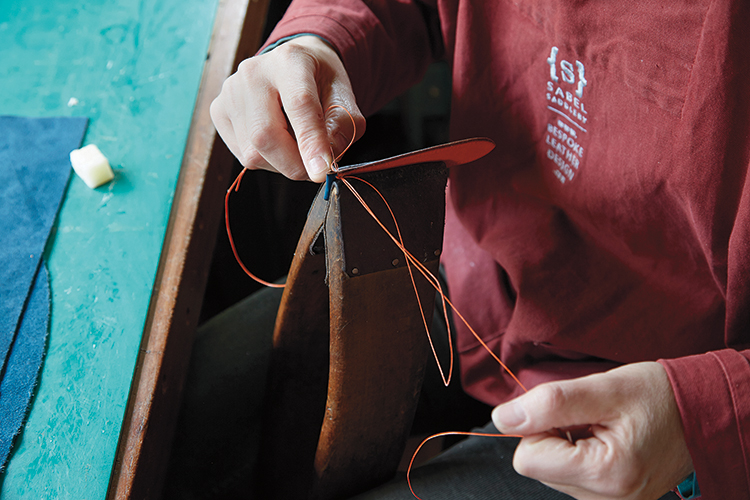
And we don’t make the holes with a needle—a common misconception. Saddlers’ needles are, in fact, blunt, and it’s a carefully honed, diamond-shaped awl that makes the hole, guided by the stitch marks prepared earlier. You do have to keep the position of the awl consistent, at a 45-degree angle and horizontal to the leather, otherwise the stitches are uneven.
A hand-stitched item should look as good at the back as it does at the front, a sign of a well-made product from an experienced maker. You will also see that the stitches are at an angle—it’s called a cast—and this is usually a sign of hand stitching, although there are some sewing machines that can replicate this effect.
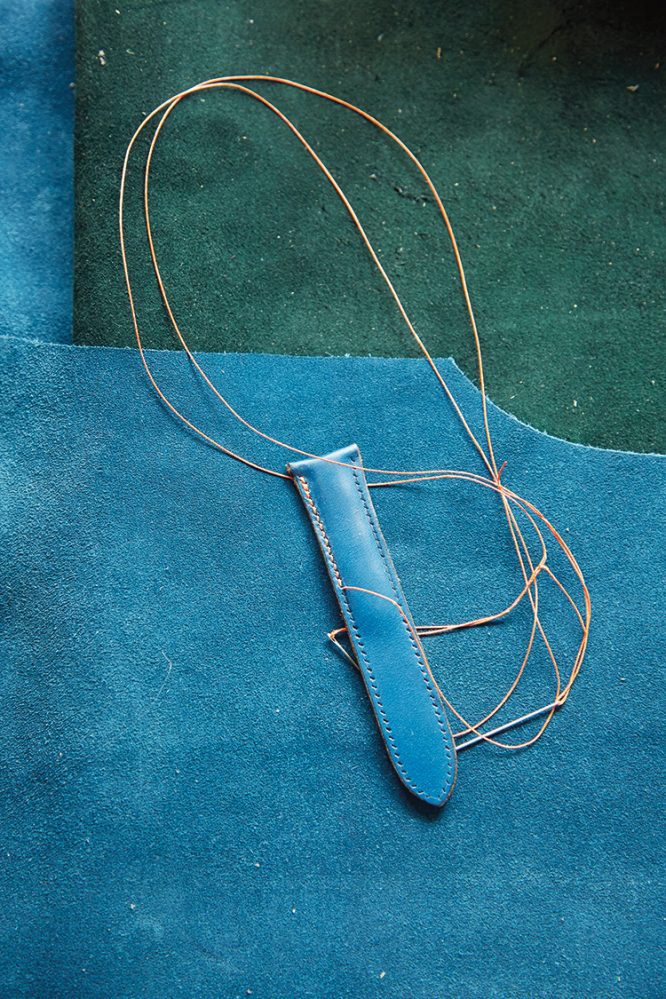
Thread is finished by back stitching rather than knotting, keeping the surface of the work smooth, and the stitches are then very gently tapped with a tack hammer.
Exposed leather edges are sanded and sealed by hand—burnished using a cow bone/slicker or canvas cloth, a lubricant, and elbow grease. You need patience; once you hear the “click” when polishing, you know you are burnishing the leather, in effect heating it up, closing the grain and sealing it. This is repeated several times, sanding and burnishing, to get the desired finish—you should be able to see your reflection.
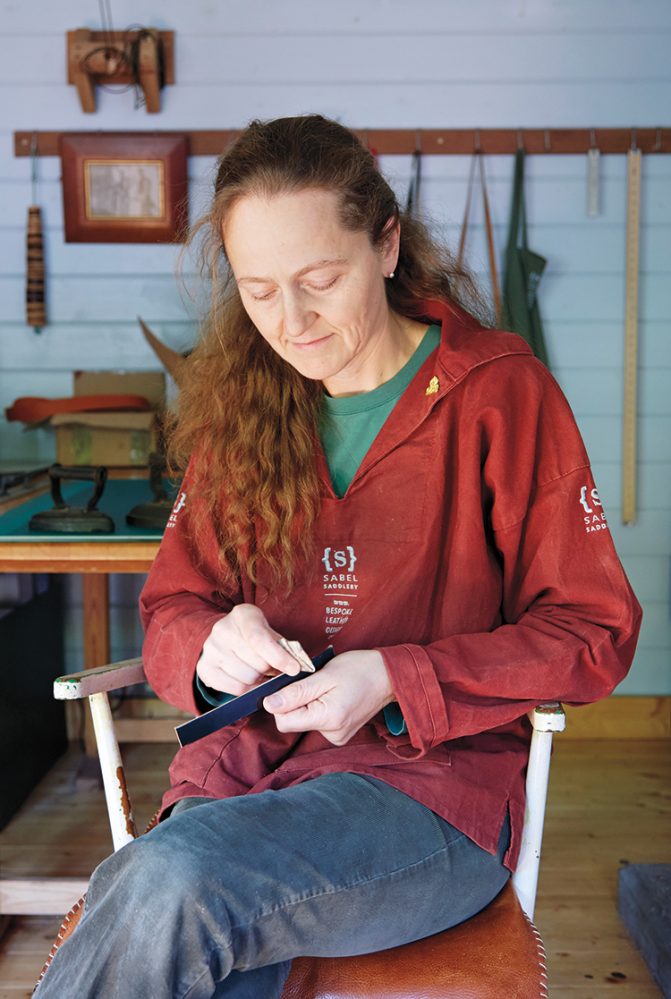
Some products, like my fob watch holders, are wet-formed. This is a traditional technique used to make armour in the Middle Ages. Leather is soaked in warm water, partially dried, and then sandwiched in between a wooden form/mould. Carefully, as if not damp enough or too wet, the leather surface can crack. Once dried, the form is taken away, and the leather keeps its shape, hardened by the water. Very hot water would have been used to make “Cuir bouilli” to make rigid shapes for armour. Dampened leather is also better for tooling, a method of stamping patterns as you would see on a Western saddle.
Influenced by my love of typography, I enjoy applying a hand-stamped lettering treatment into leather to create a surface texture that is both visual and tactile in appeal whilst allowing scope for customisation. I have offered this in the past as a hands-on, participatory experience, allowing live personalisation of memory books, decorated through the interaction of the attendees. My hand-stamped photo albums make perfect gifts as baby books and anniversary celebrations, and my memory books are most suited to guest books at weddings and memorials.
I have designed my own range of hand-made leather products that combine tradition, quality, and usability. My signature items include The Stirrup Bag (bags fabricated around recycled stirrup irons) and a modular range of stationery detailed with vintage brace elastic for closure. My work has been showcased at both Fortnum & Mason and Holland & Holland and has appeared at Buckingham Palace—in fact, HM The Queen took hold of my stirrup bag at an exhibition and declared how light it was! I have even made leather gloves for several waxwork models at Madame Tussauds around the world.
I have offered a training course to beginners and have had several apprentices—I believe it is always important to try and share one’s knowledge to keep the traditional alive, and there is immense pleasure seeing someone create something new for the first time.
The journey to Scotland from London happened just before the pandemic—after looking after my poorly mother and aunt, when they passed, my husband and I decided to make the move out of the hustle of the city to seek a quieter, rural life. We moved, with our latest three rescue kitties, into a large former manse built in 1730 in Fodderty in the Highlands of Scotland, about 25 minutes from Inverness, Mackenzie country. Here, along with running three beautiful self-catering holiday cottages, I continue to run my leather business.
Now, as a Qualified Saddler and using UK-sourced materials where possible, I continue to use traditional saddlery techniques and materials to create a range of classic, luxury leather products, specialising in bespoke and fitted watch straps; all hand-made, hand-stitched, and hand-finished in Scotland. Although I no longer offer saddlery, my services include bespoke leather design, watch straps, accessories, stationery, corporate bespoke products, and leather repair and restoration—I have a passion for restoring old luggage, furniture, and unloved leather items, bringing them back to life in order to be cherished for decades more. Whether off-the-shelf, personalised, customized, or bespoke and enhanced by my brand, design, and marketing experience, I am passionate about creating works of excellence that will last a lifetime.

Brought up in a creative and industrious family in London, at the age of 8, I watched and learned how to turn banister rails from my Master Carpenter grandfather and helped my mother and grandmother sew children’s and toy clothing to sell at markets. I’ve always enjoyed making things.

I spent the first five years of my varied careers in the theatre running a youth theatre in London and became a professional stage manager touring theatres, schools, and the Edinburgh Fringe. I then decided I wanted to pursue a creative education and went to art college, gaining a (hard to achieve!) First Class Degree in Graphic Design (BA Hons) at the famous St Martins College of Art & Design in London. A career as a creative producer followed in the early interactive CD-ROM and subsequent website era working for agencies such as Razorfish. This career culminated in my becoming Creative Director and Brand Manager, running a 20-strong, award-winning design team I developed there, and overseeing the brand at the innovative online financial services company Egg.

Sitting at my desk on the 17th floor of Canary Wharf in London, managing a team of creatives, I wondered how I had gotten there and where my own creativity was going. I wanted to do something hands-on, something practical and traditional. I had considered tailoring and millinery, but I loved the idea of working with horses, of being a saddler. A brave move after a successful 25-year career in brand, design, and theatre, in 2008 I left my job in the city to retrain as a Saddler and start my leather business. I gave up a well-paid job with benefits for a self-funded, full-time training at the only 2-year saddlery course in the county — a mere 10 miles from home.

In 2010, a Queen Elizabeth Scholarship Trust (QEST) Scholarship enabled me to expand on this training, become a Qualified Saddler, and augment my skillset in other leather crafts such as upholstery, bag making, and restoration.
Four years later, I completed the Walpole Crafted Mentorship programme, which helped me to focus my offering and concentrate on marketing my watch strap services to a luxury market—at the time, I may have been the only person in the UK to make and fit watch straps with a single hole. I arrange personal consultations to help the customer make decisions about the design of the strap: shape, leather and thread colours, additional features, and take detailed measurements. Once the strap is made, I arrange for a customer fitting, adding a single hole for a unique, customised fit (or 3 holes for mail order). It’s not a surprise I’m known as the “Watch Tailor.”
One of my customers said: “People underestimate the impact of a strap on a watch. A strap can transform a watch into something entirely different than people are accustomed to. It allows you to personalise a watch and tweak its presentation in order to make it align with your personal aesthetic and style.”

Like a bespoke jacket, the contrasting lining of a (watch) strap can discretely express your individuality.
I love working with leather—I love the smell, the feel, and the way I can manipulate it into complicated forms. Inspired by traditional saddlery techniques, materials, and aesthetics, my products are hand-cut from thick, top-grade, full-grain vegetable-tanned leather, often bridle leather used in saddlery for its strength. My favoured leather is oak bark leather from the only traditional oak bark pit-tannery in Britain, J&FJ Baker & Co. in Devon, where there has been a tannery since the Roman times.
Leather is such a versatile, durable material, and I am content in using a by-product of the meat industry, creating products that will last a lifetime.

I prepare leather by hand cutting, using a double-head knife, a tool that looks like a viking helmet. With practice, you can become efficient at cutting and skiving (thinning) using this tool. I have sourced saddlery tools from many locations, from retired Saddlers, bought new-old stock, and scoured eBay—some tools are very difficult to find, and even the modern ones aren’t always made as well as they used to be.
Leather is prepared for stitching using a stitch-marker, or pricking iron, a tool that looks like a fork. It is available in a variety of widths, depending on the quantity of stitches per inch you require, and is used to mark, not punch through, the leather. That is often a rookie mistake, inevitably damaging the tool.
“A thing of beauty is a joy forever; its loveliness increases; it will never pass into nothingness.”
John Keats (1795-1821) from “Endymion” Book 1
People are surprised that I only stitch by hand—I don’t use a sewing machine. They often comment—does it hurt? You must have strong fingers? Well, no, it doesn’t, and maybe I do, but it’s all in the preparation and technique.

Two needles are used, one threaded at each end of an armful length of linen thread. The thread is hand-waxed to stop it from twisting—strengthening, and protecting it. Linen, once wet, actually gets stronger, which is why it is used on horse tack, having to endure mud, sweat, rain, and tears.
A doublehanded saddler’s stitch is stronger than machine stitching as it creates a figure of eight through the holes, and it doesn’t unravel if a stitch is broken. What happens when you pull a loose thread on a machine-stitched bag? It unravels, of course.

And we don’t make the holes with a needle—a common misconception. Saddlers’ needles are, in fact, blunt, and it’s a carefully honed, diamond-shaped awl that makes the hole, guided by the stitch marks prepared earlier. You do have to keep the position of the awl consistent, at a 45-degree angle and horizontal to the leather, otherwise the stitches are uneven.
A hand-stitched item should look as good at the back as it does at the front, a sign of a well-made product from an experienced maker. You will also see that the stitches are at an angle—it’s called a cast—and this is usually a sign of hand stitching, although there are some sewing machines that can replicate this effect.

Thread is finished by back stitching rather than knotting, keeping the surface of the work smooth, and the stitches are then very gently tapped with a tack hammer.
Exposed leather edges are sanded and sealed by hand—burnished using a cow bone/slicker or canvas cloth, a lubricant, and elbow grease. You need patience; once you hear the “click” when polishing, you know you are burnishing the leather, in effect heating it up, closing the grain and sealing it. This is repeated several times, sanding and burnishing, to get the desired finish—you should be able to see your reflection.

Some products, like my fob watch holders, are wet-formed. This is a traditional technique used to make armour in the Middle Ages. Leather is soaked in warm water, partially dried, and then sandwiched in between a wooden form/mould. Carefully, as if not damp enough or too wet, the leather surface can crack. Once dried, the form is taken away, and the leather keeps its shape, hardened by the water. Very hot water would have been used to make “Cuir bouilli” to make rigid shapes for armour. Dampened leather is also better for tooling, a method of stamping patterns as you would see on a Western saddle.
Influenced by my love of typography, I enjoy applying a hand-stamped lettering treatment into leather to create a surface texture that is both visual and tactile in appeal whilst allowing scope for customisation. I have offered this in the past as a hands-on, participatory experience, allowing live personalisation of memory books, decorated through the interaction of the attendees. My hand-stamped photo albums make perfect gifts as baby books and anniversary celebrations, and my memory books are most suited to guest books at weddings and memorials.
I have designed my own range of hand-made leather products that combine tradition, quality, and usability. My signature items include The Stirrup Bag (bags fabricated around recycled stirrup irons) and a modular range of stationery detailed with vintage brace elastic for closure. My work has been showcased at both Fortnum & Mason and Holland & Holland and has appeared at Buckingham Palace—in fact, HM The Queen took hold of my stirrup bag at an exhibition and declared how light it was! I have even made leather gloves for several waxwork models at Madame Tussauds around the world.
I have offered a training course to beginners and have had several apprentices—I believe it is always important to try and share one’s knowledge to keep the traditional alive, and there is immense pleasure seeing someone create something new for the first time.
The journey to Scotland from London happened just before the pandemic—after looking after my poorly mother and aunt, when they passed, my husband and I decided to make the move out of the hustle of the city to seek a quieter, rural life. We moved, with our latest three rescue kitties, into a large former manse built in 1730 in Fodderty in the Highlands of Scotland, about 25 minutes from Inverness, Mackenzie country. Here, along with running three beautiful self-catering holiday cottages, I continue to run my leather business.
Now, as a Qualified Saddler and using UK-sourced materials where possible, I continue to use traditional saddlery techniques and materials to create a range of classic, luxury leather products, specialising in bespoke and fitted watch straps; all hand-made, hand-stitched, and hand-finished in Scotland. Although I no longer offer saddlery, my services include bespoke leather design, watch straps, accessories, stationery, corporate bespoke products, and leather repair and restoration—I have a passion for restoring old luggage, furniture, and unloved leather items, bringing them back to life in order to be cherished for decades more. Whether off-the-shelf, personalised, customized, or bespoke and enhanced by my brand, design, and marketing experience, I am passionate about creating works of excellence that will last a lifetime.












